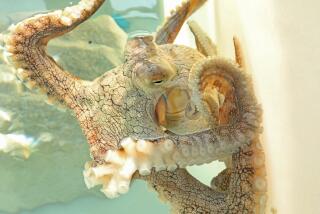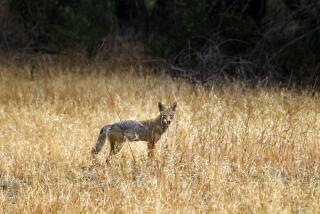Spider scientists creep up on elusive prey
The summer sun is in full force, yet these scavengers are clutching flashlights.
They will need them as they fan out across Irvine Ranch Historic Park in search of an invader that few people want to see.
One of the hunters slithers under a trailer ramp. His flashlight pops on. Others, some on tiptoe, scrutinize pipes and circuit breakers caked with grit.
Photos: A spider gallery that might make you cringe
Suddenly, Douglas Danielsen focuses on something inches from his face. “Play dead already,” he says. “Play dead.”
This is their quarry: the brown widow spider, a relatively new species to Southern California that seems to have found its utopia.
Wearing a faded orange bandanna around his head and carrying a clear bag of plastic vials, nationally known arachnologist Rick Vetter is unfazed.
“People get all worked up,” he says, handing a vial to Danielsen, 19, who captures the brown widow. “Just because it’s a spider, people freak out. I find it fascinating that people outweigh a spider by a 100,000 times and … are paralyzed by it.”
Vetter, biologist Lenny Vincent and several Fullerton College undergraduate students are here to collect brown widows, which are distinctive for their tan and white stripes and the yellow or orange hourglass marking on their bellies.
The spiders’ unique, spiky egg sacs will form the basis of a census being performed to help scientists determine why the African species has exploded in this region.
“It went from being nonexistent to spreading like wildfire,” says Vetter, cautioning that there is no way to know precisely how many brown widows are here. It would be, he says, like asking how many raindrops fall during a storm in one city.
The brown widow was first seen in the U.S. in 1935 in Florida, making its local appearance in Torrance in 2003. By documenting where it lives, what environment it prefers and how much venom it injects, scientists hope to determine if these arachnids pose a risk and whether pesticides might be effective in controlling them.
“Whenever you have a new pest come in, you want to have the biological information,” Vetter says.
The scientists have found that the brown widow prefers dark crevices: patio furniture, the lips of planters and the undersides of mailboxes. And although its venom is more potent than that of its better-known relative, the black widow, this species is timid. As a result, Vetter says, its bite seems to carry a smaller dose of venom and pales next to the sometimes sweat-inducing pain inflicted by a black widow.
“It’s not that big of a deal,” he says, “but people see the word ‘widow’ in a name and freak out completely.”
::
Studying these spiders may be a niche science, but for Vetter it is a labor of love.
A native of Long Island, N.Y., Vetter, 56, says he has always been fascinated by science. Whenever his father said ants were stupid, Vetter wondered whether the opposite was true.
“A lot of it was people underestimated animals and they never took the time to look at them,” he says. “I was always intrigued by them and why they did certain things.”
He gravitated toward arachnids as a graduate student at Arizona State University, amazed that “this tiny spider can put a tiny bead of venom under your skin and cause havoc.”
There was an unexpected upside too.
“The fact that I was in zoology and into black widows was really a door opener for me,” Vetter says. He got used to hearing, “Are you the spider man?”
As part of their brown widow study, Vetter and Vincent put out a call to Southland residents: Send us your brown widow eggs.
Hundreds of envelopes and packages with spiders in peanut jars, amber vials and cardboard boxes piled up on Vetter’s desk and in Vincent’s home.
“Thank GOD there are folks like you willing to do this research because just the collection of these spiders has given me a bad case of the creeps,” one letter from Costa Mesa read.
Some people even opened their homes for inspection. Last month, Vincent found 43 egg sacs — each gum-ball-sized sac holds about 150 eggs — in a San Clemente backyard.
So far, the two scientists have dissected thousands of egg sacs, looking for parasites such as fly larvae or their cocoons. But despite their research, they have reached no conclusions yet.
::
At Irvine Park, Vetter records Danielsen’s find and walks slowly along the perimeter of one of the historic homes that once served as residences for ranch hands. He holds a long, metal mechanic’s mirror, searching for the distinctive egg sacs.
Later, he paws through some branches, examining webs with his bare hands. Vincent is examining the trunks. Nothing.
Vincent pulls a mirror from his back pocket and walks over to a water main behind a chain-link fence. He finds five brown widow sacs and uses a small stick to pry some of them from the cracked gray paint.
At the end of each search, Vetter takes their haul to the lab at UC Riverside for inspection. There, amid colonies of cockroaches in large gray trash cans and incubators buzzing with fleas, an inflatable spider hovers over a window and a Spider-Man doll graces a bookshelf.
Vetter opens a glass jar and a brown widow spider crawls onto his hand.
“We even have entomologists who are afraid of spiders,” he says. “I think they’re gorgeous.”
Photos: A spider gallery that might make you cringe
More to Read
Sign up for Essential California
The most important California stories and recommendations in your inbox every morning.
You may occasionally receive promotional content from the Los Angeles Times.











